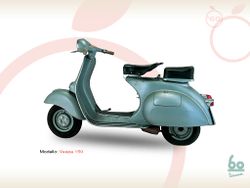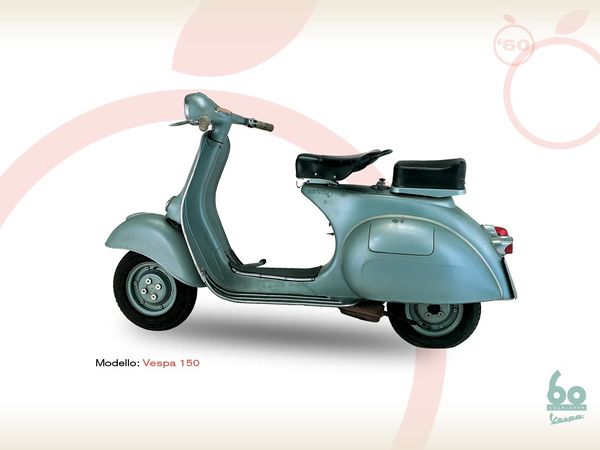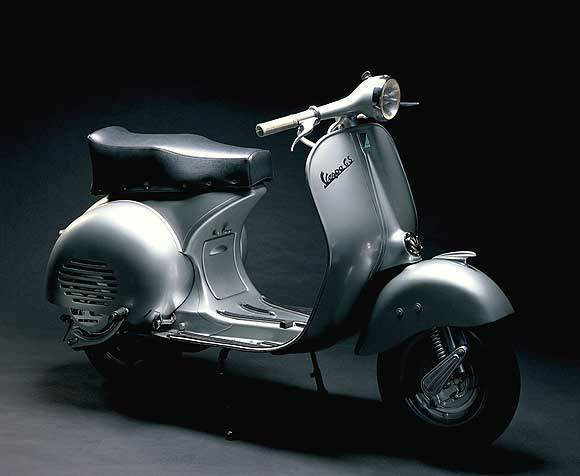Vespa 150GS
 |
|
| Vespa 150GS | |
| Manufacturer | |
|---|---|
| Production | 126 349 units |
| Engine | Two stroke, single cylinder |
| Compression ratio | 7:1 |
| Top Speed | 100 km/h / 62 mph |
| Ignition | 6 pole flywheel magneto |
| Battery | 6V |
| Transmission | 4 Speed, grip-shift, constant mesh |
| Frame | Pressed sheet steel, streamlined monocoque structure |
| Suspension | Front: Stub axle with swining hub and variable rate coil spring and double action hydraulic damper Rear: Swinging bracket for engine and wheel, with variable rate coil spring and co-axial double action hydraulic damper |
| Brakes | Front: Drum, expanding type with cooling ribs Rear: Drum, expanding type with cooling ribs |
| Front Tire | 3.5 x 10" |
| Rear Tire | 3.5 x 10" |
| Wheelbase | 1180 mm / 46.4 in |
| Weight | 100 kg / 220 lbs (dry), |
| Fuel Capacity | 12 L / 3.17 US gal |
| Manuals | Service Manual |
It could reach a top speed of 100 km/h / 62 mph.
Engine[edit | edit source]
The engine was a Air cooled, centrifugal fan cooled Two stroke, single cylinder. The engine featured a 7:1 compression ratio.
Drive[edit | edit source]
Power was moderated via the Wet, multiplate with cork inserts.
Chassis[edit | edit source]
It came with a 3.5 x 10" front tire and a 3.5 x 10" rear tire. Stopping was achieved via Drum, expanding type with cooling ribs in the front and a Drum, expanding type with cooling ribs in the rear. The front suspension was a Stub axle with swining hub and variable rate coil spring and double action hydraulic damper while the rear was equipped with a Swinging bracket for engine and wheel, with variable rate coil spring and co-axial double action hydraulic damper. The 150GS was fitted with a 12 L / 3.17 US gal fuel tank. The bike weighed just 100 kg / 220 lbs. The wheelbase was 1180 mm / 46.4 in long.
Photos[edit | edit source]
Overview[edit | edit source]
In 1956, a decade after the first model was launched, the millionth Vespa came off the line at the Pontedera factory.
Following the initial products from 1946, improvements were made to the original design and new models were introduced. The 1948 Vespa 125 had rear suspension and a bigger engine. The headlamp was moved up to the handlebars in 1953, and had more engine power and a restyled rear fairing. A cheaper spartan version was also available. One of the best-loved models was the Vespa 150 GS introduced in 1955 with a 150 cc engine, a long saddle, and the faired handlebar-headlamp unit. Then came the 50 cc of 1963, and in 1968 Vespa 125 Primavera became one of the most durable of all.
The Gran Sport or GS 150 was unveiled in 1955, a blend between style and sport. It was the first sporting scooter to achieve mass market success.
the styling was the pinnacle of Piaggio's scooter design - it had a smooth and integrated design. The body was physically bigger, the cowls' curves were exaggerated and made even more round than those on the Vespa 150. In fact, from the sloped tail to the curved legshields there was hardly a straight line anywhere on the scooter. Even the floorboards were concave.
the 150GS was the first to be fitted with a 4 speed gearbox, the carburetor increased to 23 mm and a larger exhaust was added to help the engine breath. The 150 GS is remembered as being the worlds most beautiful scooter ever produced and is highly sought after by todays collectors of vintage Vespas.
The scooter public had grown up, had changed. The Vespa had become the means of how to stand out in a society which was slowly coming to terms with a new social entity: youth.
For the first time, a vehicle born as a quiet way for lots of people to get about suddenly discovered it was capable of breath taking performance.
Born from the Piaggio racing team experience, the GS was the first scooter with a 150 cc engine and was highly sporty in concept. It had a direct fuel injection engine generating 8 bhp at 7,500 revs and reached a top speed of 63 mph. It had a four-speed gearbox, and its long saddle and large 10" wheels gave the Vespa line a new, aggressive look.
| Make Model | Vespa 150 GS |
|---|---|
| Year | 1955 - 61 |
| Production | 126 349 units |
| Engine Type | Two stroke, single cylinder |
| Displacement | 145.5 cc / 8.8 cub in |
| Bore X Stroke | 57 x 57 mm |
| Compression | 7:1 |
| Carburetor | Dell'Orto UB 23 S3 |
| Cooling System | Air cooled, centrifugal fan |
| Fuel Mixture | 1:15 |
| Ignition | 6 pole flywheel magneto |
| Starting | Kick start |
| Battery | 6V |
| Clutch | Wet, multiplate with cork inserts |
| Max Power | 6.0 kW / 8.2 hp @ 7500 rpm |
| Transmission | 4 Speed, grip-shift, constant mesh |
| Final Drive | Direct drive |
| Frame | Pressed sheet steel, streamlined monocoque structure |
| Front Suspension | Stub axle with swining hub and variable rate coil spring and double action hydraulic damper |
| Rear Suspension | Swinging bracket for engine and wheel, with variable rate coil spring and co-axial double action hydraulic damper |
| Front Brakes | Drum, expanding type with cooling ribs |
| Rear Brakes | Drum, expanding type with cooling ribs |
| Wheels | Interchangeable |
| Front Tire | 3.5 x 10" |
| Rear Tire | 3.5 x 10" |
| Dimensions | Length: 1700 mm / 67 in Width: 700 mm / 27 in Height: 1050 mm / 41 in |
| Wheelbase | 1180 mm / 46.4 in |
| Ground Clearance | 285 mm / 11.2 in |
| Turning Radius | 1400 mm / 55 in |
| Dry Weight | 100 kg / 220 lbs |
| Fuel Capacity | 12 L / 3.17 US gal |
| Reserve | 1.2 L / 0.3 US gal |
| Consumption Average | 3.1 L/100 km / 32 km/l / 80 US mpg |
| Top Speed | 100 km/h / 62 mph |
| Colours | Metallic blue/green |
| Sources | Scooterlounge.com |

